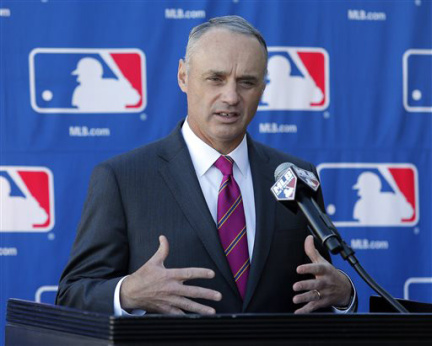Recently, Rob Manfred has been taking strides to make a positive impact on baseball by instituting pace-of-play rules. It is noble and valiant effort, it is as it seems that commissioners never seem to make much of a difference. Yet, are they changes that the baseball community is ready to embrace or even changes that Major League Baseball should adopt?
A quick summary of the rule changes follow, while a more comprehensive look can be found here. They include half-inning break clocks, 2:25 minutes of allotted time for locally televised games and 2:45 minutes of allotted time for nationally televised games, managers to challenge calls from the dugout instead of having to enter the field of play and all batters must keep at least one foot in the batter’s box at all times.
Obviously, there are supporters on both sides: Some seem to think a quicker pace of play will liven up the game, while others think that it harms the integrity of the game. Although I do not have any problems with the new rule changes, it’s not due to the fact that I feel as though the changes will bring about positive change; rather, it’s that I do not believe that the new changes will reap any change at all..
The one change that I was at first excited to see was that managers would have to challenge a previous play from the dugout instead of entering the field of play. Previously, managers would take advantage of the necessity to enter the field of play by taking their time to officially challenge the play so that the team’s video-analysts would be able to determine whether or not the play was worth challenging. Upon seeing this change, I thought that it would eliminate this aspect of the challenge. However, I was wrong. After reading more into the rule, it turned out managers would still be able to resort to their video-analysts. As ESPN.com cites, “Managers are being told they can still wait for their video consultants to let them know whether to challenge a play and that they won’t necessarily be under any pressure to challenge plays more quickly,” which, in effect, changes absolutely nothing.
The possible pace-of-play rule that I fear the most is that pitchers will be forced to pitch within a certain time limit. This rule would obviously impact pitchers in a negative way, but it would also be detrimental to hitters as well.
Unlike other sports, baseball success does not necessarily hinge on momentum and streaks. Baseball is a team sport intertwined with the concept of individual sports, as a lot of gameplay focuses on individual players. In saying that, the pressures which individual players face in certain situations are unrivaled to those of other sports as the outcome of games very often hinges on that of one player in baseball. The factors that players face in high-tension situations are already enough: the roar of the crowd and their own minds. And, even if the clock was set to a time that wouldn’t be thought to affect any pitcher, the ticking of the clock would still be ever present in the pitcher’s mind, therefore potentially affecting his performance.
Although a pitch clock would evoke unnecessary pressures, another important aspect which I believe some people fail to recognize is that a pitch clock would take away from the beauty of baseball. Baseball has a sense of integrity to it, a sense of ever-present history. Throughout the years, baseball has never changed – it has remained the same game that it was when it was first played, and there is something special about that.
In a recent press conference, Jon Lester said “If you [use a pitch clock] you take the beauty out of the game. There’s such a cat-and-mouse game as far as messing up hitters’ timing, messing up pitchers’ timing. Different things that fans and people that have never played this game don’t understand. I feel like if you do add a clock it just takes all the beauty away from the game.”
I think the best way to put this debate is, “if it ain’t broke, don’t fix it.”





